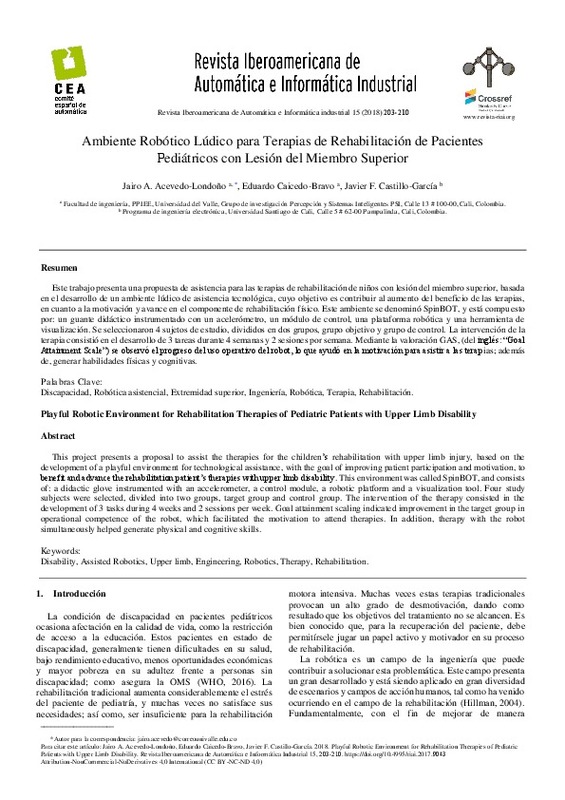Acevedo, J. A., Bravo, E. C., & García, J. F. C. (2017). Aplicación de tecnologías de rehabilitación robótica en ni-os con lesión del miembro superior. REVISTA SALUD UIS, 49(1), 103-114.
Brooke, J. (1996). SUS-A quick and dirty usability scale. Usability evaluation in industry, 189(194), 4-7.
Borsci, S., Federici, S., & Lauriola, M. (2009). On the dimensionality of the System Usability Scale: a test of alternative measurement models. Cognitive processing, 10(3), 193-197. https://doi.org/10.1007/s10339-009-0268-9
[+]
Acevedo, J. A., Bravo, E. C., & García, J. F. C. (2017). Aplicación de tecnologías de rehabilitación robótica en ni-os con lesión del miembro superior. REVISTA SALUD UIS, 49(1), 103-114.
Brooke, J. (1996). SUS-A quick and dirty usability scale. Usability evaluation in industry, 189(194), 4-7.
Borsci, S., Federici, S., & Lauriola, M. (2009). On the dimensionality of the System Usability Scale: a test of alternative measurement models. Cognitive processing, 10(3), 193-197. https://doi.org/10.1007/s10339-009-0268-9
Bangor, A., Kortum, P., & Miller, J. (2009). Determining what individual SUS scores mean: Adding an adjective rating scale. Journal of usability studies, 4(3), 114-123.
Cook, A. M., Hoseit, P., Liu, K. M., Lee, R. Y., & Zenteno-Sanchez, C. M. (1988). Using a robotic arm system to facilitate learning in very young disabled children. IEEE Transactions on biomedical engineering, 35(2), 132-137. https://doi.org/10.1109/10.1351
Cook, A. M., Liu, K. M., & Hoseit, P. (1990). Robotic arm use by very young motorically disabled children. Assistive Technology, 2(2), 51-57. https://doi.org/10.1080/10400435.1990.10132150
Cook, A. M., Meng, M. H., Gu, J. J., & Howery, K. (2002). Development of a robotic device for facilitating learning by children who have severe disabilities. IEEE transactions on neural systems and rehabilitation engineering, 10(3), 178-187. https://doi.org/10.1109/TNSRE.2002.802877
Cook, A. M., Bentz, B., Harbottle, N., Lynch, C., & Miller, B. (2005). School-based use of a robotic arm system by children with disabilities. IEEE transactions on neural systems and rehabilitation engineering, 13(4), 452-460. https://doi.org/10.1109/TNSRE.2005.856075
Cook, A., Encarnação, P., & Adams, K. (2010). Robots: Assistive technologies for play, learning and cognitive development. Technology and Disability, 22(3), 127-145.
Colombo, R., Pisano, F., Micera, S., Mazzone, A., Delconte, C., Carrozza, M. C., Dario, P., Minuco, G., 2005. Robotic techniques for upper limb evaluation and rehabilitation of stroke patients . IEEE transactions on neural systems and rehabilitation engineering 13 (3), 311-324. https://doi.org/10.1109/TNSRE.2005.848352
Colomer, C., Baldovi, A., Torrome, S., Navarro, M., Moliner, B., Ferri, J., Noe, E., 2013. Efficacy of armeo® spring during the chronic phase of stroke. study in mild to moderate cases of hemiparesis. Neurologia (English Edition) 28 (5), 261-267. https://doi.org/10.1016/j.nrl.2012.04.017
Forman, G. (1986). Observations of young children solving problems with computers and robots. Journal of Research in Childhood Education, 1(2), 60-74. https://doi.org/10.1080/02568548609594908
Frank Lopresti, E., Mihailidis, A., Kirsch, N., 2004. Assistive technology for cognitive rehabilitation: State of the art. Neuropsychological rehabilitation 14 (1-2), 5-39. https://doi.org/10.1080/09602010343000101
Harwin, W. S., Ginige, A., & Jackson, R. D. (1988). A robot workstation for use in education of the physically handicapped. IEEE Transactions on Biomedical Engineering, 35(2), 127-131. https://doi.org/10.1109/10.1350
Hillman, M., 2004. 2 rehabilitation robotics from past to present-a historical perspective . En: Advances in Rehabilitation Robotics . Springer, pp. 25-44. https://doi.org/10.1007/10946978_2
Hogan, N., Krebs, H. I., Charnnarong, J., Srikrishna, P., & Sharon, A. (1992, September). MIT-MANUS: a workstation for manual therapy and training. I. In Robot and Human Communication, 1992. Proceedings., IEEE International Workshop on (pp. 161-165). IEEE.
Kiresuk, T. J., & Sherman, R. E. (1968). Goal attainment scaling: A general method for evaluating comprehensive community mental health programs. Community mental health journal, 4(6), 443-453. https://doi.org/10.1007/BF01530764
Kwee, H., Quaedackers, J., Van de Bool, E., Theeuwen, L., & Speth, L. (1999). POCUS project: adapting the control of the MANUS manipulator for persons with cerebral palsy. In Proceedings of International Conference on Rehabilitation Robotics (pp. 106-114).
Maciejasz, P., Eschweiler, J., Gerlach-Hahn, K., Jansen-Troy, A., Leonhardt, S., 2014. A survey on robotic devices for upper limb rehabilitation. Journal of neuroengineering and rehabilitation 11 (1), 3. https://doi.org/10.1186/1743-0003-11-3
Sale, P., Lombardi, V., Franceschini, M., 2012. Hand robotics rehabilitation: feasibility and preliminary results of a robotic treatment in patients with hemiparesis . Stroke research and treatment 2012. https://doi.org/10.1155/2012/820931
Seitz, R., Kammerzell, A., Samartzi, M., Jander, S., Wojtecki, L., et al., 2014. Monitoring of visuomotor coordination in healthy subjects and patients with stroke and parkinson?s disease : an application study using the pablo-device. lnt J Neurorehabil 1, 113.
Tejima, N. (2001). Rehabilitation robotics: a review. Advanced Robotics, 14(7), 551-564. https://doi.org/10.1163/156855301742003
WHO, 2016. World report on disability. WHO.
Wille, D., Eng, K., Holper, L., Chevrier, E., Hauser, Y., Kiper, D., Pyk, P., Schlegel, S., Meyer-Heim, A., 2009. Virtual reality-based paediatric interactive therapy system (pits) for improvement of arm and hand function in children with motor impairment?a pilot study. Developmental Neurorehabilitation 12 (1), 44-52. https://doi.org/10.1080/17518420902773117
[-]








